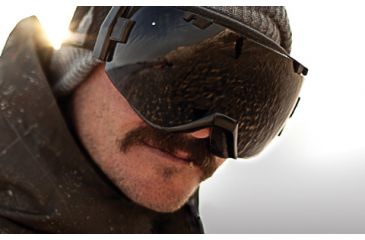There are three basic things to look for when you are buying snow ski goggles. Those are how they fit on your face, the frame features, and the different lense options. The superior coverage offered by goggles versus sunglasses protects you from these on-the-mountain hazards:![]()
- At high altitudes, the air is thinner and filters less ultraviolet (UV) rays.
- The sun's reflection on snow is brighter and more intense.
- Wind can make your eyes tear and blur your vision.
- Ice particles can get into your eyes, especially when descending fast.
- Twigs and branches can hit your eyes when dropping through the trees.
How Your Goggles Should Fit
There shouldn't be any gaps between your skin and the snowboard eyewear/skiing goggles. This could cause too much air could flow through, and dry out your eyes or cause fogging. It's important to stop touching or adjusting your goggles. If you need to do this the goggles are not right for you.
Ski goggles should be strapped on snugly over your ski helmet or hat. Make sure your ski goggles are helmet compatible, meaning they fit securely on your face without being stretched or bent to fit over or around the helmet. Many brands keep helmets in mind and so should you.
The feel of the foam on your face should be consistent all the way around the goggles, there shouldn't be any uncomfortable pressure points.
Goggles, Bolle Nebula Goggles, Bolle Stoke Ski Goggles, Bolle Nova ski goggles, Spy Soldier Goggles and Spy Bias Goggles, all of them are Bole ski goggles.
Check if the skiing goggle will fit over any prescription eyeglasses that you wear. If you are looking for such snowboard goggles look for the words and letter OTG (Over The Glasses) Ski Goggle. They offer more room on the interior of the frame to allow room for your regular eyeglasses.
Goggle RX Adapter for Ski Goggles and Snowboard Goggles. If you would rather have prescription ski goggles, check for goggles that use prescription Rx adapter.
Frame Features
The ski goggles frame should be made of a flexible material.
Make sure your goggles have good vents in either the frame or the lenses. Sometimes they are foam covered air portals, to let air flow through the skiing goggle to keep them fog-free. Bolle Simmer Ski Goggles is a good example of fogless ski goggles. Bolle sunglasses Equalizer technology uses a waterproof, breathable vent to equalize air pressure between the goggle lenses and eliminate moisture. The result is distortion-free vision and no fogging at any altitude. We have the top brands of Snowboarding Goggles, from Wiley X, Bolle and Julbo to Spy Optic and Body Specs, so you're sure to find the perfect pair for you.
Lens Options
All goggle lenses are made from durable polycarbonate which provides ultimate protection from shattering and UVA, B and C radiation. Most ski or snowboard goggles, look for double lenses. They perform the best by creating a thermal barrier. Double lenses won't fog up on you. Spy Optic lens system joins and completely seals the dual lenses with polyurethane-based glue. The airtight chamber between the ski goggle lenses results in the elimination of between-the-lens fogging and altitude-induced snow goggle lens distortion. Spy Optics offers dual lenses in all Spy Optic Ski Goggles. Bolle Scream goggles lens, Bolle Jinx goggles and Bolle Simmer Ski goggles come with double lenses that provide exceptional optics and a superior seal.
Polycarbonate lens material is generally the most durable. Most Goggles feature double polycarbonate lenses, ensuring superior optical quality.
Cylindrical double lenses are very popular. They provide good optics for a reasonable price.
Spherical double lenses have superior optics. These lenses are better at providing fog-free vision.
Vented lenses will also help to keep your vision clear. Bolle Y6 Snowboarding / Ski OTG Goggles and the Smith Optics Gambler Snow Goggles have this feature.
Lens Colors
- Clear lenses are best for extremely low light conditions or for riding at night
- Photochromic lenses change depending upon the light conditions (for example from a light pink or orange, to a dark pink or orange or simply clear to tint). Let the lens do all the work.
- Blue lenses are perfect for rainy conditions and overcast days, they increase contrast and brighten up the landscape. They intensity the white light.
- Persimmon or Rose lenses increase contrast in most conditions. This lens with a silver gun mirror is ideal for most riding conditions. Pink ski goggles are very popular nowadays.
- Citrus, Amber, Brown or any warm lenses also increase contrast, and are great for bright to medium days. Choose an option with a mirror for a darker lens for the brightest conditions.
- Polarized ski goggles lenses can cut glare that reflects from snow or ice.
- Gray lenses are best for the brightest conditions and true color representation.
Helpful reminder: a mirror coating on the lens won't affect the color through which you are looking only make it a bit darker. Also look out for branding names for mirror coatings: Gun, Spectra and Iridium is all still mirror coating.






